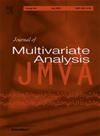Alteration detection of tensor dependence structure via sparsity-exploited reranking algorithm
IF 1.4
3区 数学
Q2 STATISTICS & PROBABILITY
引用次数: 0
Abstract
Tensor-valued data arise frequently from a wide variety of scientific applications, and many among them can be translated into an alteration detection problem of tensor dependence structures. In this article, we formulate the problem under the popularly adopted tensor-normal distributions and aim at two-sample correlation/partial correlation comparisons of tensor-valued observations. Through decorrelation and centralization, a separable covariance structure is employed to pool sample information from different tensor modes to enhance the power of the test. Additionally, we propose a novel Sparsity-Exploited Reranking Algorithm (SERA) to further improve the multiple testing efficiency. Such efficiency gain is achieved by incorporating a carefully constructed auxiliary tensor sequence to rerank the -values. Besides the tensor framework, SERA is also generally applicable to a wide range of two-sample large-scale inference problems with sparsity structures, and is of independent interest. The asymptotic properties of the proposed test are derived and the algorithm is shown to control the false discovery at the pre-specified level. We demonstrate the efficacy of the proposed method through intensive simulations and two scientific applications.
基于稀疏性重排序算法的张量相关结构变化检测
张量值数据经常出现在各种各样的科学应用中,其中许多可以转化为张量相关结构的变化检测问题。在本文中,我们在普遍采用的张量-正态分布下表述这个问题,并针对张量值观测值的两样本相关/偏相关比较。通过去相关和集中,采用可分离协方差结构将不同张量模态的样本信息聚在一起,提高检验的有效性。此外,我们提出了一种新的稀疏性利用重排序算法(SERA),以进一步提高多重测试效率。这样的效率增益是通过结合一个精心构造的辅助张量序列来重新排序p值来实现的。除了张量框架之外,SERA也普遍适用于广泛的具有稀疏结构的两样本大规模推理问题,并且具有独立的研究价值。推导了该测试的渐近性质,并证明了该算法可以将错误发现控制在预先指定的水平上。我们通过密集的模拟和两个科学应用证明了所提出方法的有效性。
本文章由计算机程序翻译,如有差异,请以英文原文为准。
求助全文
约1分钟内获得全文
求助全文
来源期刊

Journal of Multivariate Analysis
数学-统计学与概率论
CiteScore
2.40
自引率
25.00%
发文量
108
审稿时长
74 days
期刊介绍:
Founded in 1971, the Journal of Multivariate Analysis (JMVA) is the central venue for the publication of new, relevant methodology and particularly innovative applications pertaining to the analysis and interpretation of multidimensional data.
The journal welcomes contributions to all aspects of multivariate data analysis and modeling, including cluster analysis, discriminant analysis, factor analysis, and multidimensional continuous or discrete distribution theory. Topics of current interest include, but are not limited to, inferential aspects of
Copula modeling
Functional data analysis
Graphical modeling
High-dimensional data analysis
Image analysis
Multivariate extreme-value theory
Sparse modeling
Spatial statistics.
 求助内容:
求助内容: 应助结果提醒方式:
应助结果提醒方式:


